북한과 미국사이에 금방이라도 전쟁이 일어날것 같은 무서운 공갈 협박들이 잠시도 쉬지않고 전세계인들을 불안에 떨게하고 있지만, 정작 그 중앙에 있는 북한 주민들은, 김정은과 Regime의 철권 통치로 외부세계와 완전 단절시키고 있기에, 깜깜 무소식으로 오직 위대한 "김정은 동지"만 외쳐대고 있는게, 현재 북한의 실상이다. 이에 비하면, 잘먹고 잘사는 한국민들은, 촛불집회와 귀족노조들이 주도하는, 불법데 모와 젊은이들은 "Hell Korea"라고 배부른 불평불만으로 하루하루 귀중한 시간을 허비한다. 40-50년전만 해도북한보다 훨씬 더 어렵게 살았던 남한 국민들의 정신상태는, 특히 젊은이들은 그들의 부모들이 겪었던 삶의 어려움속에서 오늘의 한국건설을 위해 헌신했던 고마움을 전연 느끼지 못하고 오직 불만과 허영으로 포장된 사람들로만 보인다. 젊은이들에게 꼭 필요한 말.
"There is no heaven on earth, never,never" 이말은 지구상의 모든 이들에게 적용된다.
북한은 철저히 외부세계와 차단된 나라로 묘사되고 있으며, 21세기를 살아가는 나라라고 생각되지 않는다. 국가에서 발표한 국가규모 수치는 거의 없고, 다만 추측에 근거하여 작성되고는 있으나, 북한 주민들의 생활상에 대해서는 공식적으로 발표된바는 전연없다. 이게 북한의 실상인데, 그중에서 크게 비교되는 9가지의 실상을 아래에 옮겨봤다.
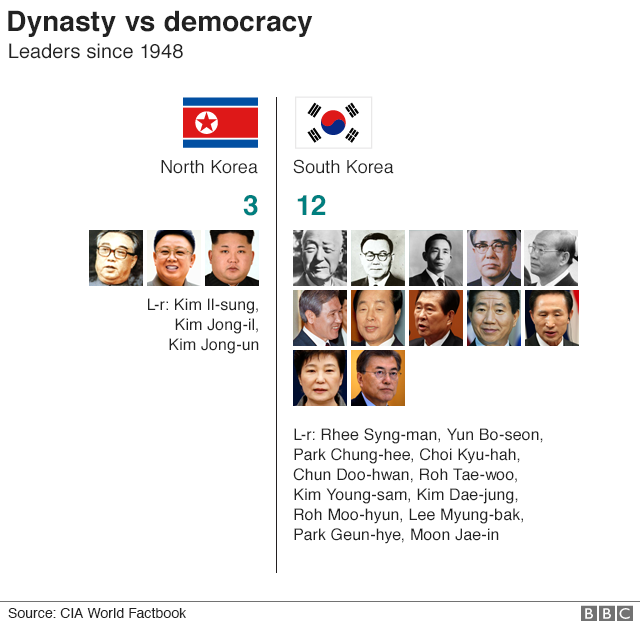
Kim Il-sung effectively founded North Korea in 1948 and his family dynasty has ruled the country ever since, with control passing from father to son.
In the same period South Korea has managed six republics, a revolution, a couple of coups and the transition to free and fair elections. In total 12 presidents have led the country, covering 19 terms of office.

Three million mobile phones might seem like a lot - but in a country of 25 million it amounts to just over one out of every ten people. Most mobile users are likely to be concentrated in the capital Pyongyang.
By contrast, with a population of some 51 million there are more mobile phone subscriptions than people in South Korea.
With effectively a single network, Koryolink, North Korea's mobile market is limited but growing. Originally established as a partnership with Egyptian telecom firm Orascom, it was for many years the only option.
However, in 2015 Orascom discovered that North Korea was setting up a rival network, Byol, and was forced to disclose to investors that it had effectively lost control over the service's three million plus subscribers.
There's reason to be sceptical about those subscriber numbers though.
Research by the US-Korea Institute at SAIS suggests that some growth might be down to North Koreans calculating that it's cheaper to buy an additional subscription than additional air time.
As well as a scarcity of mobiles, the vast majority of North Koreans are only permitted access to the country's 'private internet' - effectively a closed intranet operating on a national scale.
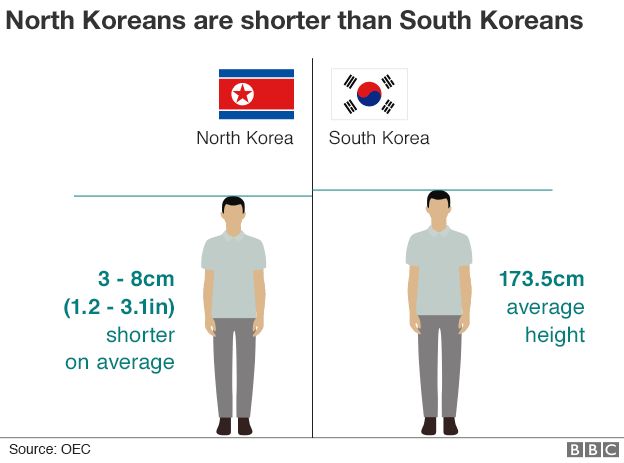
It may sound like an urban myth, but there is some research to suggest that North Korean men are on average shorter than their South Korean counterparts.
Professor Daniel Schwekendiek from Sungkyunkwan University in Seoul studied the heights of North Korean refugees measured when they crossed the border into South Korea and found an average 3-8cm (1.2 -3.1 inch) difference.
Schwekendiek points out that the height difference cannot be attributed to genetics, because the two populations are the same.
He also rejects criticism that suggests that refugees are more likely to be impoverished, and therefore of smaller stature.
Food shortages are thought to be the main factor in why North Koreans are generally shorter.
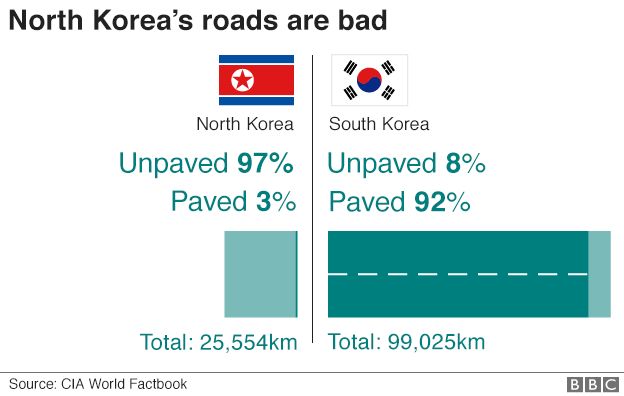
Images from North Korea's capital Pyongyang often show stretches of wide, pristine motorway unoccupied by traffic, but outside the city it's another story.
North Korea has some 25,554 km of roads, according to 2006 figures, but just 3% are actually paved, amounting to a meagre 724km (449 miles).
It's also estimated that only about 11 out of every 1,000 North Koreans owns a car, which means a long queue at the bus stop for most people who need to travel.
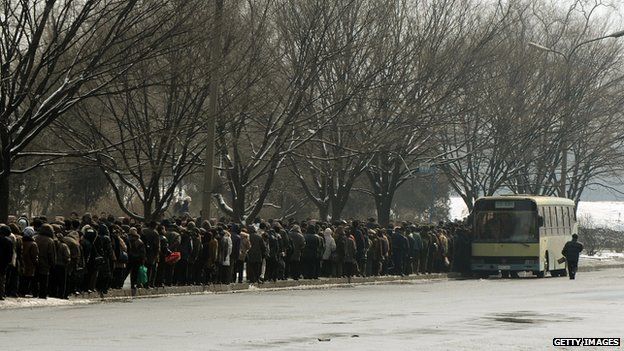 GETTY IMAGES
GETTY IMAGES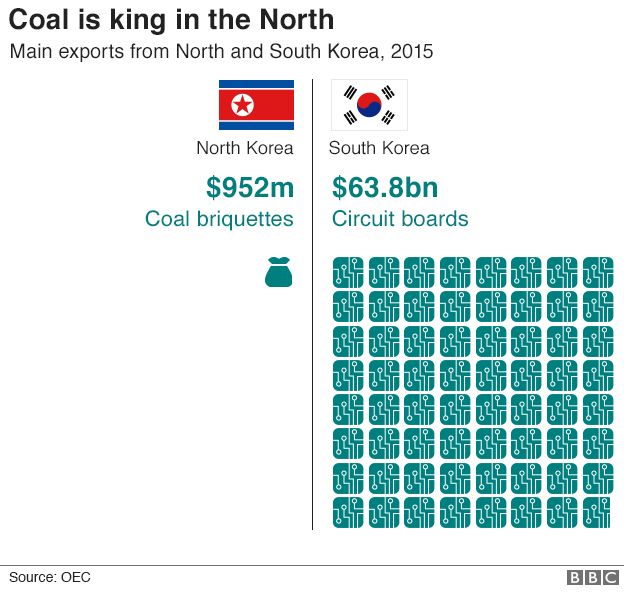
North Korea relies on coal exports to keep its economy above water - but it's hard to measure their true value as the data comes from countries receiving the coal.
Much of North Korea's coal is exported to China, which banned imports in February 2017. However some analysts question the nature of the sanction.
"There are folks who track ships and have seen North Korean ships docking at coal terminals at Chinese ports even after the ban. I do believe that China has disrupted coal imports, but not completely," says Kent Boydston, research analyst at the Peterson Institute for International Economics.
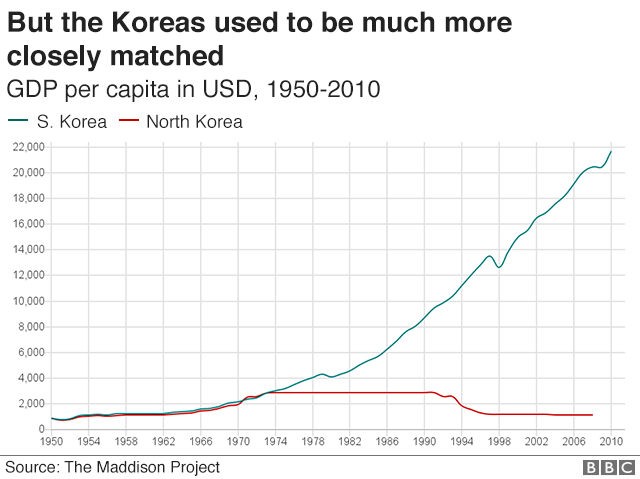
Until 1973 North and South Korea were pretty evenly matched in terms of wealth.
Since then, South Korea has rocketed ahead to become one of the world's leading industrial producers, with companies like Samsung and Hyundai becoming global household names.
North Korea stagnated in the 1980s as the country stuck rigidly to its state-run system.

While North Korea is the 52nd largest country by population, it is considered to have the world's fourth largest army.
Military spending is estimated to account for as much as 25% of GDP, and almost every North Korean man undergoes some form of military training.
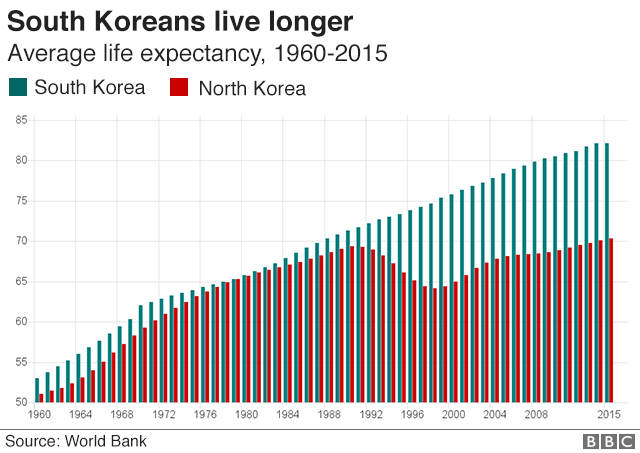
A series of famines in the late 1990s caused a sharp drop in life expectancy in North Korea, but even without that factor, the North lags nearly 12 years behind.
Food shortages persist and are one of many reasons why South Koreans generally live longer.
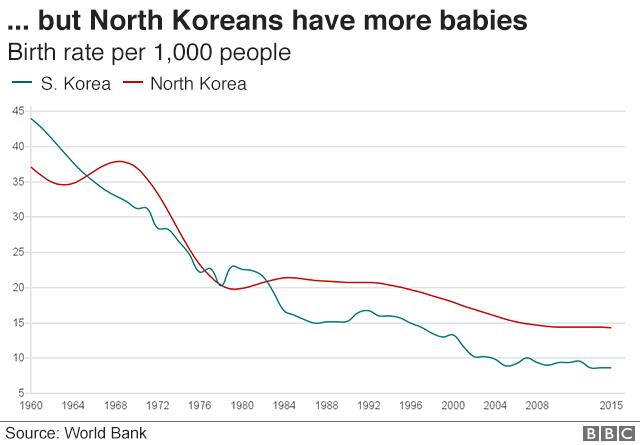
In 2017 South Korea's birth rate hit a record low as the country continued a decade-long struggle to boost the country's birth rate.
It has spent about $70bn (£53bn) handing out baby bonuses, improving paternity leave and paying for infertility treatment.
As North Korea and the United States continue to trade threats, we have little idea how the war of words is perceived to the people of North Korea because the regime of Kim Jong-un maintains an iron grip over the population, carefully controlling access to the outside world.
The country is often depicted as isolated and thoroughly out of step with the 21st century. Statistics are hard to get and often based on estimates, but what can they tell us about life in the North?
Produced by Alex Murray and Tom Housden. Graphics by Mark Bryson, Gerry Fletcher and Prina Shah.
http://www.bbc.co.uk/news/world-asia-41228181
No comments:
Post a Comment